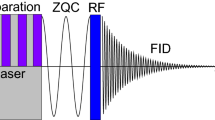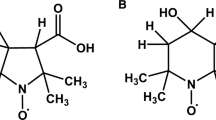Overview
- Authors:
-
-
Claude Richard
-
Laboratoire de Chimie Radicalaire, Equipe de Recherche N° 136 associée au C.N.R.S, Nancy Cedex, France
-
Pierre Granger
-
Laboratoire de Chimie Théorique, Université de Nancy I, Nancy Cedex, France
Access this book
Other ways to access
About this book
Anomalous electron-spin state populations in the Electron Paramagnetic Re sonance (EPR) spectra of radicals formed during radio lysis experiments were observed in 1963 by FESSENDEN and SCHULER [170a]. This phenomenon did not receive much attention at the time. In 1967, BARGON, FISCHER, and JOHNSEN [5] and independently WARD and LAWLER [7,8] reported a similar phenomenon for Nuclear Magnetic Resonance (NMR) spectra taken during radical reactions: emission or enhanced absorption, or both. The earliest attempts to explain this new NMR phenomenon treated these effects in a way similar to that of Dynamic Nuclear Polarization (DNP) or the Overhauser effect. Although the polarization has a completely different origin, DNP gave its name to this effect: Chemically Induced Dynamic Nuclear Polariza tion (CIDNP). [The name Chemically Induced Dynamic Electron Polarization (CIDEP) was introduced later by analogy with CIDNP]. After the initial publica tions, all the new data demonstrated that the first theory could not be correct. In 1969, a new theory was proposed by CLOSS [18] and independently by KAPTEIN and OOSTERHOFF [23] and called the radical-pair theory. This mechanism was proposed to account for the observations of polarization in both NMR and EPR. The radical-pair theory is based on weak interactions in a pair of radicals: the strength of interaction between the electronic states of the radicals depends in particular on the nuclear-spin states.
Similar content being viewed by others
Article
Open access
23 June 2021
Article
21 September 2018
Table of contents (5 papers)
-
-
- Claude Richard, Pierre Granger
Pages 5-5
-
- Claude Richard, Pierre Granger
Pages 7-22
-
- Claude Richard, Pierre Granger
Pages 23-73
-
- Claude Richard, Pierre Granger
Pages 75-105
-
- Claude Richard, Pierre Granger
Pages 107-115
-
Back Matter
Pages 117-130
Authors and Affiliations
-
Laboratoire de Chimie Radicalaire, Equipe de Recherche N° 136 associée au C.N.R.S, Nancy Cedex, France
Claude Richard
-
Laboratoire de Chimie Théorique, Université de Nancy I, Nancy Cedex, France
Pierre Granger




